Glossary
-
Abbreviation marks
standardised graphic symbols, used to enter particular words or groups of letters, constituting a system of abbreviations. They were used especially in the Middle Ages, and knowledge of them is essential to decipher texts created with their use.
-
Abbreviations
a system for shortening words or expressions (Latin abbreviare - to shorten). The types of abbreviation that appear are the shortening of words or expressions through:
ŌĆó truncation (see; suspension),
ŌĆó drawing in (see; contraction),
ŌĆó overwriting letters or a letter,
ŌĆó a short form defined by an abbreviation sign.┬Ā -
Brachygraphy
the science of researching systems for shortening words used in old writing. The art of shortening (abbreviation) written words, already used in ancient times, developed significantly in the Middle Ages. The use of short forms helped writers to enter text more quickly, ensured space saving and, in the same way, the effective use of writing materials (especially expensive parchment).
-
Calligraphy
the art of clear and aesthetic writing, often also artistic. It was introduced into Polish schools as a subject by the National Education Committee. The science of calligraphy, through arduous exercises, was to develop patience and diligence.

-
Capitals
large letters of the alphabet. Writing where all letters have the same height (in printing this was known as single case).

-
Catchword
designation of quires in a book by placing the word beginning the quire (or its fragment), at the end of the previous quire. Together with the signature mark, the objective was to ensure control over the suitable order of quires in books. Also see quire, signature mark.
-
Charta italica
a type of parchment, the so-called ŌĆ£southernŌĆØ parchment. Thin and delicate, it was prepared from sheep, goat or lamb skin, tanned, smoothed and coated only on one side and written on that side. Also see parchment.
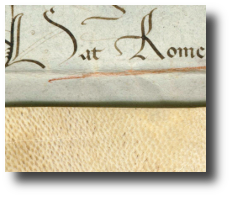
-
Charta theutonica
a type of parchment, the so-called ŌĆ£northernŌĆØ parchment. It was prepared from calf skin, tanned on both sides, which made it possible to write on both sides.
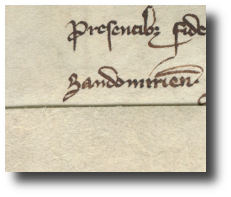 Also see parchment.
Also see parchment. -
Colophon
a note placed sometimes by medieval scribes at the end of manuscripts containing an explicit, the date of finishing the book, information about the scribe himself (name and sometimes his function). Occasionally, the colophon was complemented by the personal thoughts of the scribe, calls for prayer, curses against book thieves or a light-hearted summons for payment. Colophon developed from the narrow forms of┬Ā explicit. See explicit, incipit.
-
Contraction
shortening of a word by removing the final letters, omitting letters from the middle of the word, writing only the letters at the beginning or end of the word, or sometimes even letters appearing in the middle of the word, e.g. Dr (doctor) or Ltd (limited).
-
Cover
external lining, protecting the block of a book. Made of canvas, leather, material and paper, etc. It served mainly to protect and adorn books. For more about covers, see The art of writing. Covers.
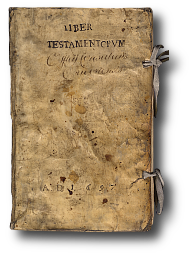
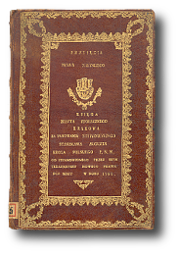
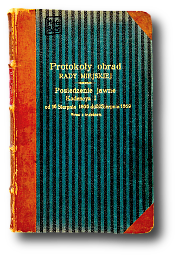
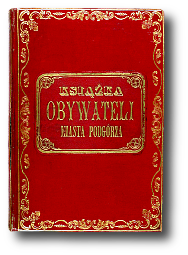
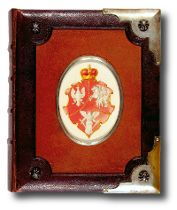
-
Epigraphy
a science researching writing inscribed into hard materials - stone, metal and wood. This is mainly connected with research into inscriptions on gravestones and monuments.
-
Erasing
a method of removing writing mistakes or dirt from parchment by scratching them using a knife (Latin rasura - scratching, from the word radere ŌĆō to scratch, rub out). Such places were then smoothed with chalk or a pumice stone.
-
Explicit
a word placed at the end of text, signifying the end of the work or its part, beginning from the word explicit (Latin explicare ŌĆō to end, to carry out). Afterwards, the title of the work was usually written. Also see incipit, colophon.
-
Filigree
in other words, water mark. A graphic mark pressed into handmade paper, identifying the paper producer. The mark was placed on a wire mesh touching the paper pulp, in its place the obtained paper is thinner and lighter, and the mark itself is best seen while viewing the paper under light. With its use, it is possible to date a manuscript and to approximately define its place of origin.
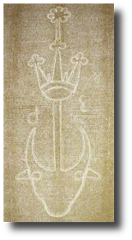
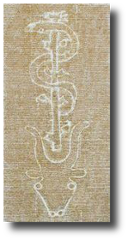
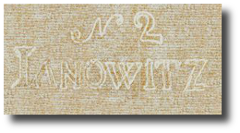
-
Fleuron
decoration in the form of ornamental plants filling an initial letter, the margins or a larger fragment of paper.
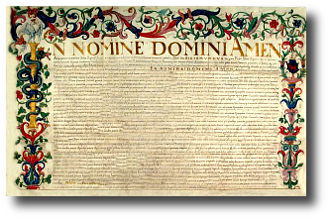
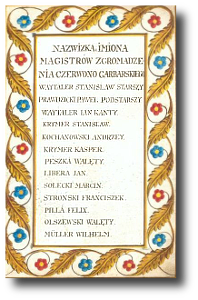
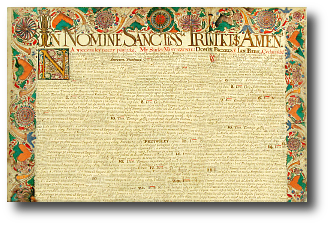
-
Incipit
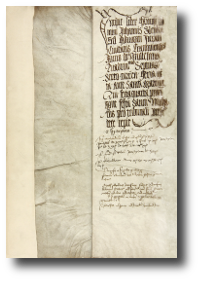 the first words in medieval books. This was the name of the author and the title of the work, usually beginning with the word incipit (Latin. incipere - to begin). Also see explicit, colophon.
the first words in medieval books. This was the name of the author and the title of the work, usually beginning with the word incipit (Latin. incipere - to begin). Also see explicit, colophon. -
Incunables
(Latin┬Āin cunabulis┬Ā- in infancy), the oldest examples of printed writing. The first printers copied manuscripts, therefore prints from the earliest period of printing have many similarities to manuscripts, e.g. the type of writing or decoration.
-
Initial
a letter beginning a paragraph of text, differing from other letters in its shape, size, colour or decoration. The word ŌĆ£initialŌĆØ comes from the Latin initium (beginning). Initials are divided into figures (taking human forms or those of whole scenes) as well as ornamental (geometric forms, plant and animal themes).
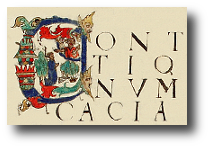

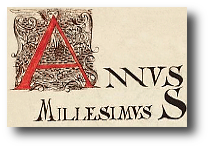
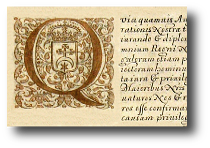
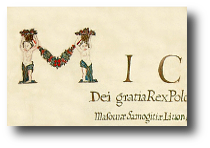
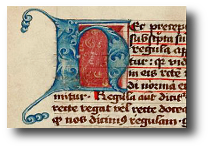
-
Ink
a product for writing, a substance serving to write text with the help of a quill. In the Middle Ages, ink was black or dark brown. It was created from vitriol, copper and gall (from tree leaves) with added rubber, water, sometimes beer, wine or vinegar. The proportions of the components affected the level of its later fading. Thanks to the differences in ink colour, it is possible to now recognise entries added later. For decorating documents, coloured ink was prepared.
-
Ligature
the connection of neighbouring letters, which often obtained new graphic forms which made their recognition difficult. The sign &, which still functions today, is the ligature of the Latin letters ŌĆ£etŌĆØ.
-
Lineation
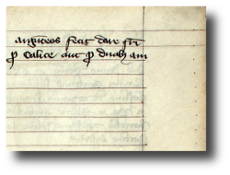 adding a net of even lines to a blank sheet of writing material, making writing easier for scribes. These were generally horizontal lines designating the distance between lines of writing, but sometimes there were also vertical lines defining the width of columns for writing. Initially, these lines were designated by holes in the margins of the page and these points were connected with lines carved using a graver, later they were drawn with lead pencils, and finally with ink.
adding a net of even lines to a blank sheet of writing material, making writing easier for scribes. These were generally horizontal lines designating the distance between lines of writing, but sometimes there were also vertical lines defining the width of columns for writing. Initially, these lines were designated by holes in the margins of the page and these points were connected with lines carved using a graver, later they were drawn with lead pencils, and finally with ink. -
Metal book cover elements
metal elements placed on the book cover, such as: corner pieces, chains, various types of buckles, or covers. Their goal was to protect the block of the book against damage and rubbing of the decorations, as well as to ease their closing. They were often also a decoration of the book - intricately engraved, openwork, with creative shapes.
Also see cover.
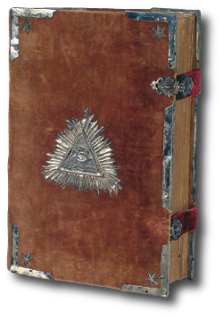
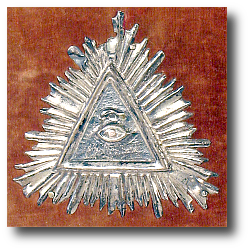
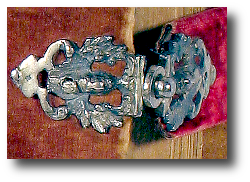
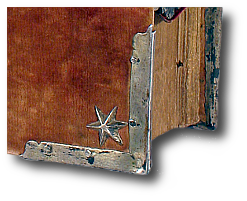
-
Minuscule
small letters of the alphabet. Writing where not all the letters have the same height.

-
Numeration
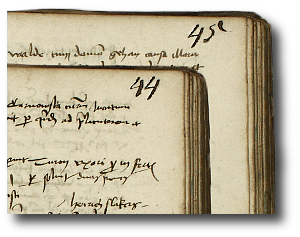 Numbering of the cards of a manuscript. Popularised in the 13th century, Roman numerals were initially used, and later Arab numerals. The idea still functions today in archives. Also see pagination.
Numbering of the cards of a manuscript. Popularised in the 13th century, Roman numerals were initially used, and later Arab numerals. The idea still functions today in archives. Also see pagination. -
Pagination
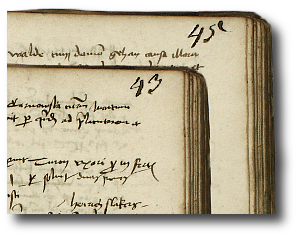 numbering of the pages of a manuscript. Popularised in the 14th century, Roman numerals were initially used, and later Arab numerals. This idea still functions in archives. Also see numeration.
numbering of the pages of a manuscript. Popularised in the 14th century, Roman numerals were initially used, and later Arab numerals. This idea still functions in archives. Also see numeration. -
Palimpsest
in other words, rewritten manuscripts, were formed on reused parchment after the removal of previous writing. This practice was connected with the fact that parchment was a very expensive writing material, so there were cases in which it was reused. Old ink was removed using chemical methods (e.g. by soaking parchment in milk which dissolved the ink) or mechanically ŌĆō by scratching out old writing. Often, thanks to the imprecise work of such operations, it is possible to read the old text under the new writing.
-
Parchment
the most common writing material in the Middle Ages, it is suitably prepared thin animal skin (most frequently sheep, goat or calf). The skin is soaked, tanned and cleaned, then dried and smoothed, and sometimes also bleached. In Europe, there were two types of parchment ŌĆō the so-called ŌĆ£southernŌĆØ parchment (used in Italy, Spain and southern France) and ŌĆ£northernŌĆØ (Germany, Poland, Hungary, Scandinavia, northern France and England). Also see charta theutonica, charta italica.
-
Probatio pennae
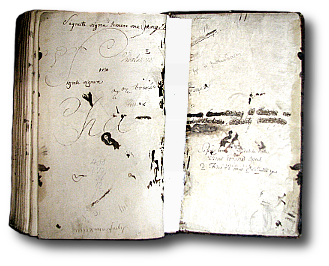 a test by the scribe of the quality of the quill, which was popular in the Middle Ages. The test of the quill was carried out on the margins of the text or on the inside of the manuscript cover.
a test by the scribe of the quality of the quill, which was popular in the Middle Ages. The test of the quill was carried out on the margins of the text or on the inside of the manuscript cover. -
Quill
a writing tool helping to write on papyrus, parchment and paper. In the Middle Ages and later, the most popular were bird quills (goose, swan). The quill was cut at an angle, with a special sharp knife. A precise cut was important in order to obtain the desired shape of the lines used by the scribe.

-
Quire
part of a book consisting of a defined number of pages. Today, it is usually 16 pages. In medieval manuscripts, a quire was created by any number of double pages (generally 5-6), with care taken so that it was not too thick. These quires were numbered using signature marks and also marked by catchwords, so that they would be connected in the correct order, creating a book. Such a way of preparing a book for printing is still used today. Also see signature mark, catchword
-
Signature mark
definition, with the help of Roman or Arabic numerals, of the order of quires in books. Signature marks are usually placed in the lower part of the last page of the quire. Also see quire.
-
Suspension
a type of abbreviation, shortening of a word by cutting part of it, e.g. prof. (professor).
-
Vellum
the most delicate and most luxurious type of parchment, obtained from the skin of unborn or newly-born lambs.
-
Water mark
see filigree.